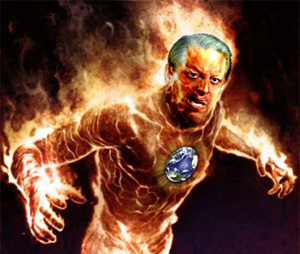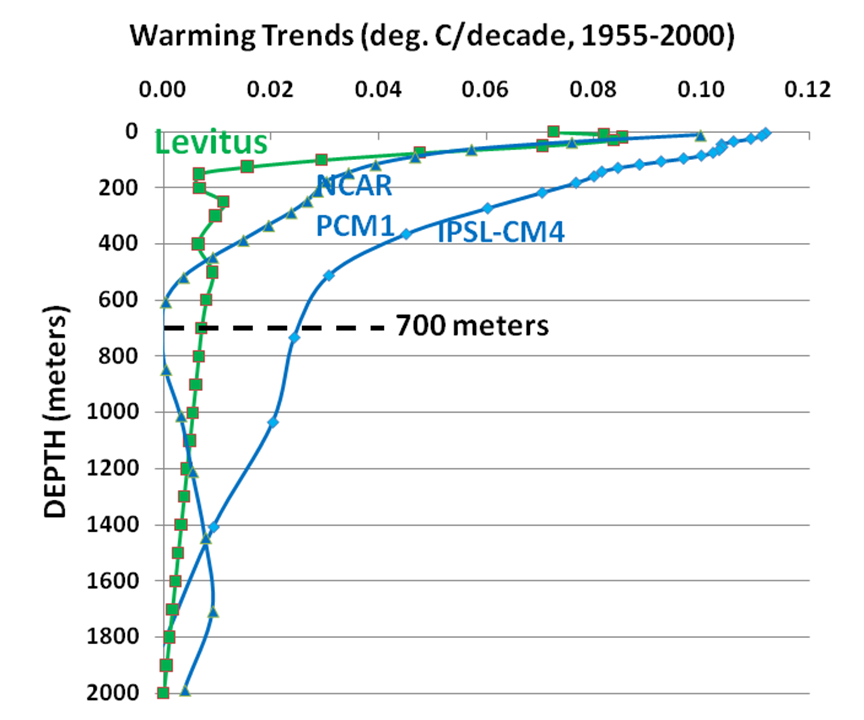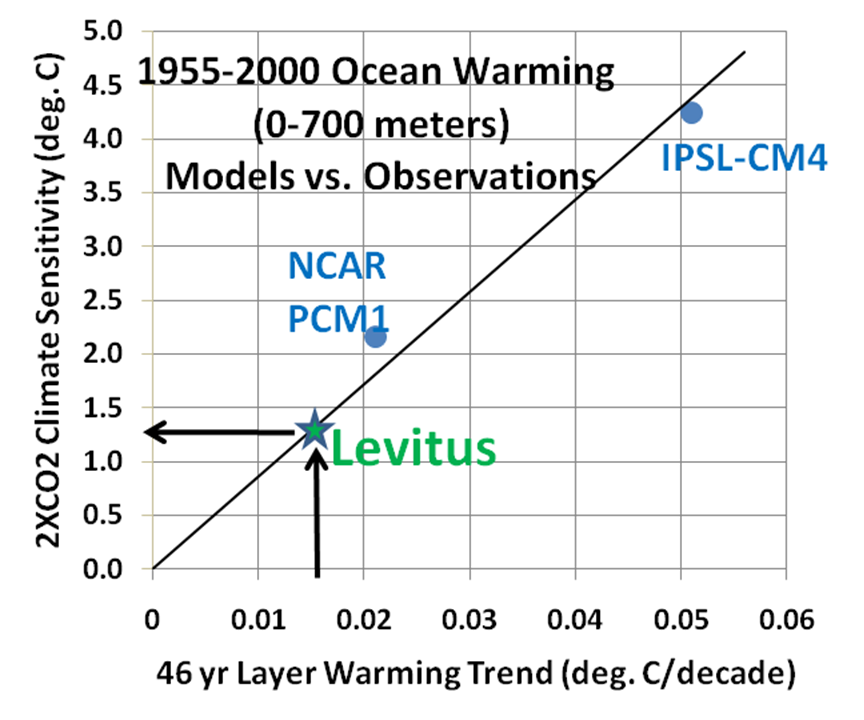NOTE: For those who are offended by my bringing up Al Gore in this post (but are apparently not offended by Gore falsely accusing scientists like me of being ‘global warming deniers’), I suggest you just focus on the evidence I present. You are invited to offer an alternative explanation for the evidence, but I will not allow you to divert attention from it through irrelevant “copy and paste” factoids you have gathered from other scientific publications. If you persist, I will be forced to adopt the RealClimate tactic of deleting comments, which so far I have been able to avoid on this blog. We’ll just call it “fighting fire with fire”.
 As I and others have pointed out, the 20th Century runs of the IPCC climate models have, in general, created more virtual warming in the last 50 years than the real climate system has warmed.
As I and others have pointed out, the 20th Century runs of the IPCC climate models have, in general, created more virtual warming in the last 50 years than the real climate system has warmed.
That statement is somewhat arguable, though, since the modelers can run a number of realizations, each with its own “natural” year-to-year internal climate variability, and get different temperature trends for any given 50-year period.
Furthermore, uncertainty over how fast heat is being mixed into the deep ocean also complicates matters. If extra surface heating from more CO2 is being mixed deeper and faster than the modelers have assumed, then climate models warming the surface too fast in the past 50 years does not necessarily mean we will not see their forecasts come true eventually.
As Kevin Trenberth has recently alluded to, it only delays the day of reckoning.
Are More Expensive Models Better?
I have tried in recent posts to estimate climate sensitivity by using a simple forcing-feedback-diffusion model, and tuning it to match observations (which is exactly what the Big Boys do), but it appears that our critics will always question the validity of a simple model, even though it contains the same fundamental physics the IPCC models must also abide by.
So, let’s skip the simple model entirely, and just compare the IPCC climate models to the observations.
IPCC Models versus Ocean Observations, 1955-2000
Since so many people are now pointing to ocean heat content increases, rather than surface warming, as a better index of how sensitive our climate system is, let’s see how observed ocean warming compares to the warming simulated by two very different IPCC climate models.
We have begun analyzing the deep ocean temperature output from the 20th Century runs of the IPCC AR4 climate models. The first we chose were one of the most sensitive models (IPSL-CM4) and one of the least sensitive models (NCAR PCM1).
There is a simple way to use these models to get some idea of what the observed ocean warming tells us about climate sensitivity.
We can simply compare each of the models’ rate of ocean warming during 1955-2000 to their known climate sensitivity, and then see what the warming rate in the Levitus ocean temperature observations suggests for a climate sensitivity in the real climate system.
The following plot shows the temperature trends, as a function of ocean depth, between 1955 (when the ocean observations start) and 2000 (when the climate model experiments end) for those 2 models as well as in the Levitus observations (click for larger version):

Clearly, the most sensitive model (IPSL-CM4) warms the ocean the most, the least sensitive model (NCAR PCM1) warms the ocean much less, and the Levitus observations appear to exhibit the least warming. (NOTE: I have linearly extrapolated the Levitus observations from the deepest reported level, 700 m, to an assumed zero trend at 2,000 m depth.)
If we compute the average warming trends for the 0-700 m layer for the 2 models, and compare them to the known sensitivity of those models, we get the 2 blue dots in the following plot (we will be adding as many models to this as possible later; click for larger version):

If we then use the model relationship between 1955-2000 warming and climate sensitivity (the solid line), we see that the warming trend in the Levitus observations fall on that at a climate sensitivity of 1.3 deg. C.
If you are wondering what the results are if we go deeper, from 700 meters to 2,000 meters deep (keeping in mind we have assumed that the observed warming goes to zero at 2,000 m depth), the answer is that it is nearly the same: 1.4 deg. C, rather than 1.3 deg. C.
This is similar to the kinds of numbers I have been getting recently using a simple forcing-feedback-diffusion model and matching the Levitus observations directly with it. This level of warming is below the 1.5 deg. lower limit that the IPCC has set for total warming in response to 2XCO2.
Obviously, we need to add more of the IPCC models to this comparison, which we will be doing in the coming weeks, to see if there is indeed a strong relationship between model warming and model sensitivity, which there should be if the different models used similar climate forcings.
But the results should not depart too much from what is shown above because the line must go through (0,0) on the graph (zero climate sensitivity means zero warming), and the upper end of the line will be fixed by the 3 most sensitive IPCC climate models, of which IPSL-CM4 is one.
Could Climate Sensitivity be even Lower?
The above analysis assumes there have been no natural forcings of warming. But to the extent that recent warming was partly due to some natural process, this would mean climate sensitivity is even less.
Discussion
Once again we see evidence that the IPCC models are too sensitive, which means they are predicting too much warming for our future, which means Mr. Gore needs to chill out a bit.
Also, the list of modelers’ potential excuses for their models warming more than observed is rapidly dwindling. For example,
1) If the above results are any indication, it is unlikely the heat is hiding in the deep ocean.
2) Blaming Chinese coal-fired power plants for a lack of warming is just taking the modelers anthropocentrism to an even higher plane. There seems to be no good evidence to support such a claim anyway.
3) Another trick the IPCC uses is to put error bars on both the observations and the on the model results until they overlap. It is then claimed that models and observations “agree” to within the margin of error. But what they don’t realize with this last bit of statistical obfuscation is they are also admitting that there is a HUGE disagreement between models and observations when one goes to the other end of those error bars.
“Overlapping error bars” is the last resort for getting two numbers to appear to agree better than they really do.
It’s time for climate modelers to face up to the explanation they have been avoiding at all cost: the climate system is simply not nearly as sensitive as they claim it is.
If they ever have to admit the climate system is insensitive, it is the end of the IPCC and the policy changes that institution was originally formed to advance.

 Home/Blog
Home/Blog



